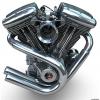Niacinamide may be important in increasing NAD+
The follwing are excerpts from
http://www.life-enha...d-nad-nad-world
Changes in NAD+ metabolism have been associated with several pathologies, including neurodegenerative diseases, cancer, cardiovascular disease, and normal ageing.4 In fact, the authors of paper #4 suggest that, NAD+ synthesis through the kynurenine pathway [de novo synthesis of NAD+ from tryptophan] and/or salvage pathway [from nicotinamide] is an attractive target for therapeutic intervention in age-associated degenerative disorders.
PARP1 has been reported in the brains of Alzheimers disease patients, as well as in those with diabetes, MTPT-caused Parkinsons disease, shock, and other conditions. It has been suggested that PARPs may play a role in aging by promoting NAD+ depletion. One study5 reported that PARP-1 activity in mononuclear blood cells increases with aging in at least thirteen mammalian species. In another study,5A researchers reported that [o]ur results suggest that oxidative stress induced NAD+ depletion could play a significant role in the aging process, by compromising energy production, DNA repair and genomic surveillance. The latter study5A examined the effect of aging on intracellular NAD+ metabolism in the whole heart, lung, liver and kidney of female Wistar rats, reporting that [o]ur results are the first to show a significant decline in intracellular NAD+ levels and NAD/NADH ratio in all organs by middle age (i.e., 12 months) compared to young (i.e., 3 month old) rats The strong positive correlation observed between DNA damage associated NAD+ depletion and Sirt1 activity suggests that adequate NAD+ concentrations may be an important longevity assurance factor.
The authors of one paper5B write that when cells are subjected to oxidative stress by exposure to H2O2 [hydrogen peroxide], PARP-1 is activated and SIRT1 activity is robustly reduced, as PARP-1 activation limits NAD+ bioavailability. Treatment with PARP inhibitors in these circumstances allows the cell to maintain NAD+ levels and SIRT1 activity. these observations indication that PARP-1 is a gatekeeper for SIRT1 activity by limiting NAD+ availability.
The authors of paper #4 report that [p]revious work from our group has shown for the first time that resveratrol induces a dose-dependent increase in activity of the NAD+ synthetic enzyme nicotinamide mononucleotide adenyl transferase (NMNAT1) but that this is unpublished data.
the activity of SirT1 relies on NAD+ as a necessary coenzyme. The paper6A goes on to describe how, in its study of exercise in mice, chronic contractile activity (exercise) has a robust effect on mitochondrial biogenesis and that resveratrol acted synergistically with exercise to increase mitochondrial content when SirT1 was activated. [T]he maximal effect of RSV [resveratrol] requires both SirT1 and a condition of energy demand in muscle that would be high in NAD+ and AMP, cofactors which activate SirT1 and AMPK, respectively
There are three main physiological precursors: tryptophan, niacin, and niacinamide. It is reported that, the administration of radiolabeled nicotinamide and nicotinic acid [niacin] has clearly shown that nicotinamide is a better precursor of NAD+ and that nicotinic acid is rapidly cleared by being converted to nicotinamide and excreted as nicotinuric acid.6B Resveratrol was reported in paper #4 (but only as unpublished data) to dose-dependently increase the activity of the NAD+ synthetic enzyme nicotinamide mononucleotide adenyl transferase. In another paper,7 quercetin was reported to oxidize NADH to NAD+ in rat liver, thus increasing the availability of NAD+. However, as the researchers also explain, direct measurements of NADH/NAD+ are very difficult to perform.7 This was as of the papers publication in 2005. The researchers inferred the NADH/NAD+ ratio from the ratio of beta-hydroxybutyrate to acetoacetate. Quercetin has also been reported to be a PARP-1 inhibitor.7B Niacinamide is known to be an inhibitor of PARP, thus may prevent the decrease in NAD+ that results from PARP activity. There is a salvage pathway of specific enzymes that converts niacinamide to NAD+.
Niacinamide (NAM) As a PARP Inhibitor May Explain NAMs Antiviral Effects
Interestingly, PARP is reported to be critical for the integration of foreign DNA, as absence of the PARP enzyme interrupts the HIV life cycle.7C An early study published in 1996 on the effects of niacin reported that a daily niacin (combining niacin and niacinamide) intake in AIDS patients that equaled only 34 times the U.S. recommended daily allowance (at that time) of 20 mg/day experienced slower progression and improved survival.7D That was, of course, well before the current multidrug cocktails were developed that enable HIV infected individuals to survive 20 years or more, but still demonstrates the anti-viral effects of the vitamin.
Other natural PARP inhibitors include the flavonoids fisetin and tricetin8 and flavone
Full disclosure: my wife sells Quercetin and Fisetin, mentioned above as NAD+ precursors via inhibiting NAD+ robbing PARP1, on Ebay
Edited by maxwatt, 26 May 2014 - 03:44 AM.









































